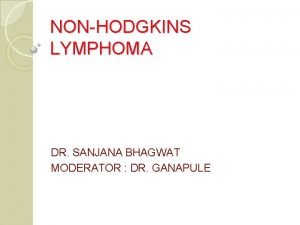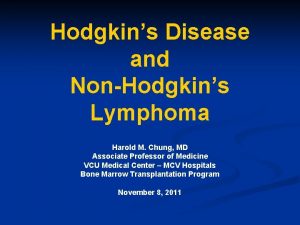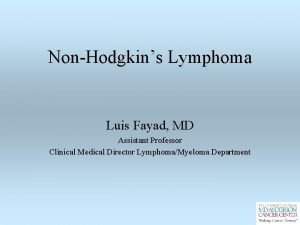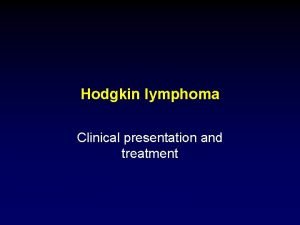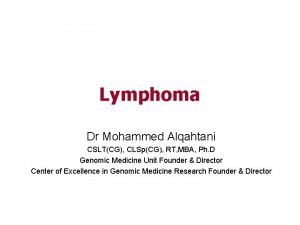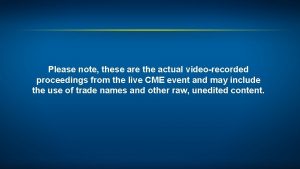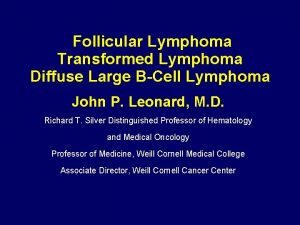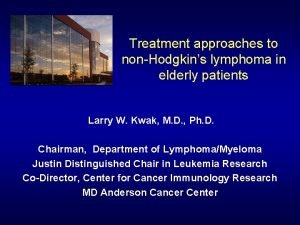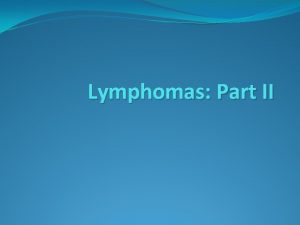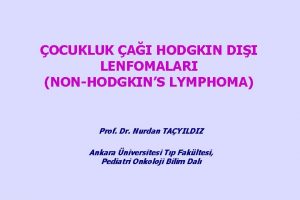NonHodgkins Lymphoma Luis Fayad MD Assistant Professor Clinical













- Slides: 13

Non-Hodgkin’s Lymphoma Luis Fayad, MD Assistant Professor Clinical Medical Director Lymphoma/Myeloma Department

Non-Hodgkin’s Lymphoma • Non-Hodgkin’s lymphomas (NHL) are a heterogeneous group of malignant lymphomas. There are many different subtypes, every few years the classification is updated. Today, morphology, immunophenotype, molecular, cytogenetics, and other techniques are used for diagnosis. • Treatment generally depends on the aggressiveness of the disease (indolent, aggressive, or very aggressive) • Current ICD-9 -CM diagnosis code range 200. 0_ – 200. 8_ and 202. 0_ – 202. 9_

Behavior • Indolent – these lymphomas grow slowly. The majority of NHLs are considered indolent. Indolent lymphomas are generally considered incurable with chemotherapy and/or radiation therapy. • Aggressive – these lymphomas have a rapid growth pattern. This is the second most common form of NHL and are curable with chemotherapy. • Very Aggressive – these lymphomas grow very rapidly. They account for a small proportion of NHLs and can be treated with chemotherapy. Unless treated rapidly, these lymphomas can be life threatening.

WHO/REAL Classification of Lymphoid Neoplasms B-Cell Neoplasms Mature (peripheral) T neoplasms Precursor B-cell neoplasm T-cell chronic lymphocytic leukemia / small Precursor B-lymphoblastic lymphocytic lymphoma leukemia/lymphoma T-cell prolymphocytic leukemia (precursor B-acute T-cell granular lymphocytic leukemia. II lymphoblastic leukemia) Aggressive NK leukemia Mature (peripheral) B-neoplasms Adult T-cell lymphoma/leukemia (HTLV-1+) B-cell chronic lymphocytic leukemia / small lymphocytic Extranodal NK/T-cell lymphoma, nasal type# Enteropathy-like T-cell lymphoma** lymphoma Hepatosplenic γδ T-cell lymphoma* B-cell prolymphocytic leukemia Lymphoplasmacytic lymphoma‡ Subcutaneous panniculitis-like T-cell lymphoma* Splenic marginal zone B-cell lymphoma (+ villous Mycosis fungoides/Sézary syndrome lymphocytes)* Anaplastic large cell lymphoma, T/null cell, Hairy cell leukemia primary cutaneous type Peripheral T-cell lymphoma, not otherwise Plasma cell myeloma/plasmacytoma characterized Extranodal marginal zone B-cell lymphoma of MALT Angioimmunoblastic T-cell lymphoma type Anaplastic large cell lymphoma, T/null cell, Nodal marginal zone B-cell lymphoma (+ monocytoid B cells)* primary systemic type Follicular lymphoma Hodgkin’s Lymphoma (Hodgkin’s Disease) Mantle cell lymphoma Nodular lymphocyte predominance Hodgkin’s lymphoma Diffuse large B-cell lymphoma Classic Hodgkin’s lymphoma Mediastinal large B-cell lymphoma Nodular sclerosis Hodgkin’s lymphoma (grades Primary effusion lymphoma† 1 and 2) Burkitt’s lymphoma/Burkitt cell leukemia§ Lymphocyte-rich classic Hodgkin’s lymphoma T and NK-Cell Neoplasms Mixed cellularity Hodgkin’s lymphoma Precursor T-cell neoplasm Lymphocyte depletion Hodgkin’s lymphoma Precursor T-lymphoblastic leukemia/lymphoma (precursor T-acute † Not described in REAL classification lymphoblastic leukemia § Formerly known as lymphoplasmacytoid lymphoma or immunocytomalymphomas II Entities formally grouped under the heading large granular lymphocyte ‡ Includes the so-called Burkitt-like ** Formerly known as intestinal T-cell

Frequency of NHL Subtypes in Adults Mantle cell (6%) Peripheral T-cell (6%) Indolent (35%) Other subtypes with a frequency 2% (9%) Composite lymphomas (13%) Armitage et al. J Clin Oncol. 1998; 16: 2780– 2795. Diffuse large B-cell (31%)

Marginal Zone Lymphoma • • Indolent Currently codes to 202. 8_ Accounts for ~10% of all lymphomas Subcategories – MALT (XRT? ) – Nodal – Extra Nodal – Splenic

Mantle Cell Lymphoma • • • Aggressive Currently codes to 202. 8_ Accounts for ~ 6% of all lymphomas Considered “incurable” with traditional RX Stem cell transplant is offered often as frontline consolidation treatment in “younger” patients

Primary CNS Lymphoma • • • Aggressive Currently codes to 202. 8_ Accounts for ~ 1 -2% of all lymphomas Different chemotherapy treatments Often requires radiation to the brain: » Brain dysfunction in younger patients » Dementia in older patients

Anaplastic Large Cell Lymphoma (ALCL) • Aggressive • Currently codes to 202. 8_ • Accounts for ~ 2% of all lymphomas – Two groups: – ALCL ALK-1+ better prognosis, more common in younger patients and children – ALCL ALK-1 -negative : as bad as any other T-cell lymphoma

Peripheral T-cell Lymphoma • • Aggressive Currently codes to 202. 8_ Accounts for ~ 7% of all lymphomas Worse prognosis, often associated with extranodal presentation • Often requiring salvage treatment and transplant

Large Cell Lymphoma • Very Aggressive • Currently codes to 200. 0_ • Accounts for ~ 31% of all lymphomas

Other Recommendations • Changes to terminology • Changes in disease process

Questions?
 Follicular nonhodgkins lymphoma
Follicular nonhodgkins lymphoma Nonhodgkins lymphoma
Nonhodgkins lymphoma Nonhodgkins lymphoma
Nonhodgkins lymphoma Dr luis fayad
Dr luis fayad Hodgkin's lymphoma clinical presentation
Hodgkin's lymphoma clinical presentation Mohamed fayad sjsu
Mohamed fayad sjsu Levels of anxiety nursing
Levels of anxiety nursing Promotion from associate professor to professor
Promotion from associate professor to professor Fok ping kwan
Fok ping kwan Lymphoma
Lymphoma Thomas hodgkin
Thomas hodgkin Non-hodgkin lymphoma
Non-hodgkin lymphoma Rbac mantle cell lymphoma
Rbac mantle cell lymphoma Burkitt lymphoma
Burkitt lymphoma
